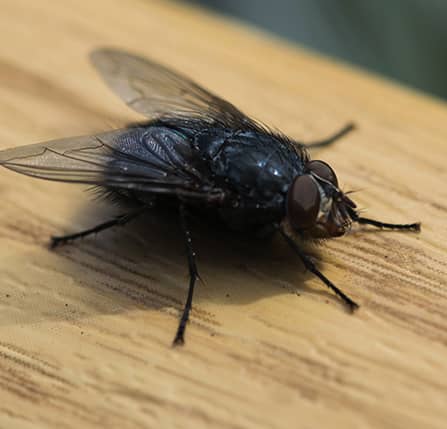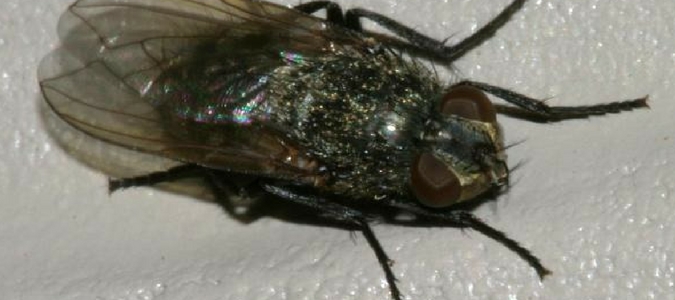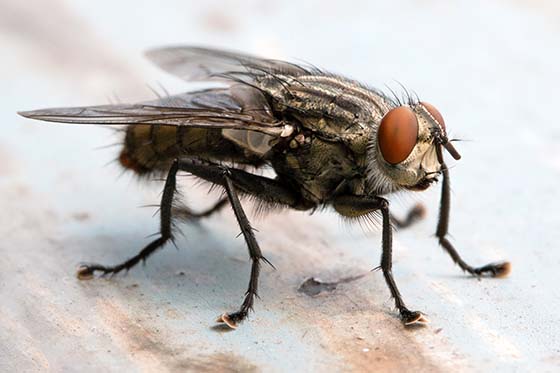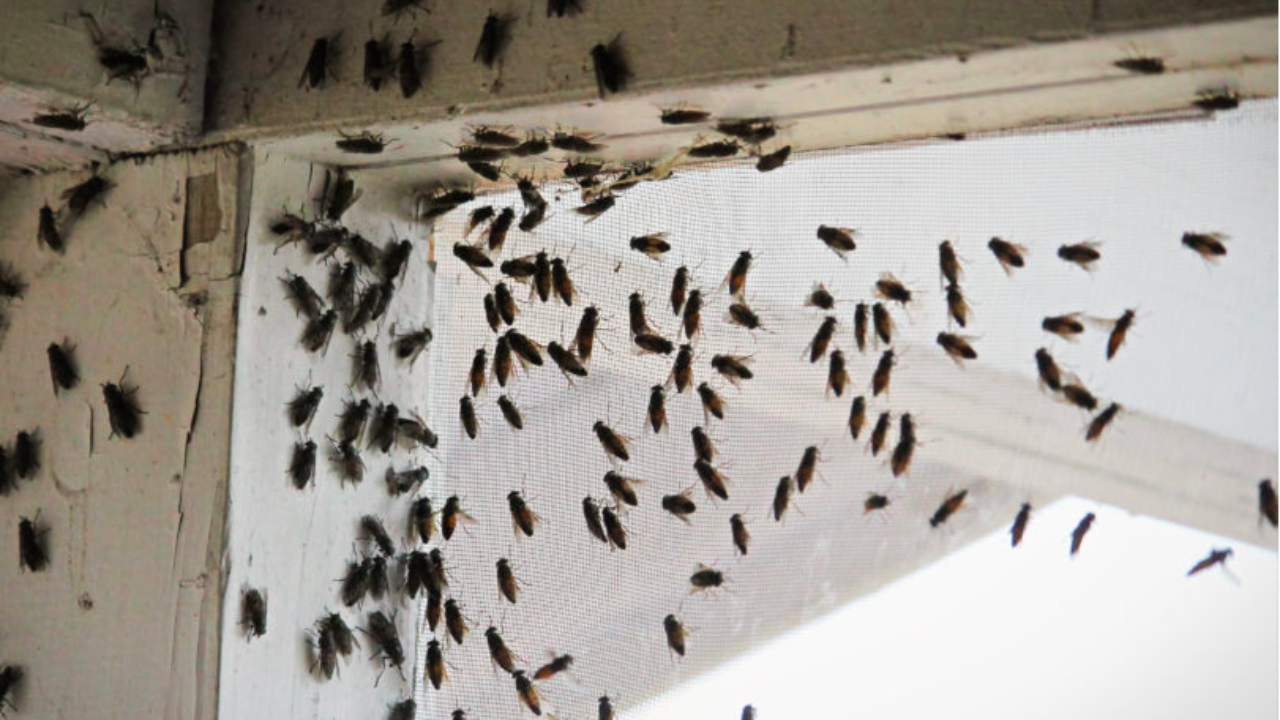Cluster Flies In House
Cluster flies have short yellow or golden coloured hairs on their thorax. Its easy to mistake any large fly for a house fly but cluster flies are visibly different.
They usually go unnoticed until one warm winter day when they are fooled into.

Cluster flies in house. Cluster flies are a bit darker and have dark and light chequered pattern on their abdomen which house flies or bottle flies do not have. The house fly sized Pollenia rudis and the fruit fly sized Thaumatomyia notata. Cluster fly larvae develop inside earthworms living in the ground outside of homes.
Adult cluster flies are dark grey in colour 8 to 10 mm long and have numerous golden or yellowish hairs on thorax. Cluster flies are light and dark grey striped flies that gather inside your home around doors and windows. Cluster flies are thought to be native to Europe and may have found their way to North America in the ballast of ships containing soil and the cluster fly host earthworms.
Cluster flies are capable of crawling through small openings in the walls of a structure. Cluster flies can be very distressing when they turn up in the autumn and sometimes in the spring too. The cluster fly is often considered a parasite of earthworms and breeds outdoors in fields and lawns during spring and summer.
Cluster flies are generally just considered a nuisance when they decide to move into your house in the fall. They are different from the most common other flies you will see in your home the Common House Fly and the Blue Bottle and do not pose the same health risks thankfully. Cluster flies are common in the loft and attic spaces of homes and business premises.
In the fall these overwintering pests try to enter your home looking for a. The warmth generated here means that flies are naturally drawn into these cavities and voids particularly during the months of October and November where they congregate in groups or clusters. There are two main species that cause concern but many others exist.
Slightly larger than the common house fly cluster flies are dull-gray in color with black markings. They are a nuisance especially in the large numbers they can sometimes get to. House flies often grow no larger than ¼ of an inch long while cluster flies grow to be twice as large measuring ½ of an inch long.
1 are slightly larger than the common house fly Musca domestica. Cluster or attic flies are the genus Pollenia in the blowfly family Calliphoridae. The eyes of the most common cluster fly Pollenia rudis are a deep red.
You can recognise cluster flies because they are larger than house flies and often appear to be slightly yellow or golden because of their tiny hairs. When theyre not busy getting on your nerves a house flys wings touch whereas a. The larvae of the fly feeds on earthworms in grass pasture or lawn areas then in late autumn and early winter the adult flies will move into homes and other buildings to hibernate over winter.
Then they cluster together for warmth in wall voids and in your attic to ride out the long cold winter. Adult cluster flies Fig. What causes cluster flies in the house.
Cluster flies are very similar in looks to house flies but they have a longer body and a yellow sheen on the thorax. Cluster flies 8 10 mm are larger in size than a house fly 6 7 mm but smaller than a bottle fly 10 14 mm. They dont lay eggs in human food unlike house flies.
The Problem with Cluster Flies. Cluster Flies are a group of flies which as the name suggests cluster at certain times of year. They enter through cracks and crevices.
These flies enter homes looking for overwintering sites during the cold months. Like many insects they move inside for the winter months. They are dull-gray with black markings and have golden-yellow.
Cluster flies prefer warm areas so homeowners often find them flying around houses on sunny days in the winter and late fall months. House flies are gray in color while most cluster flies appear black. As temperatures drop in the fall some insects become less active which is a relief.
Their silvery markings help set them apart from the smaller housefly which are large black flies with dark stripes. However those same cooler temps make cluster flies come out in full force. Unlike more familiar blow flies such as the bluebottle genus Phormia they do not present a health hazard because they do not lay eggs in human food.
They breed in soil and host on earthworms during the larva stage of their development. Cluster flies appear similar to the common house fly and blowbottle flies. Additionally cluster flies have golden hairs growing on their body whereas house flies do not.
Cluster flies are medium to large 8-15mm dopey flies with a dark gray to black non-metallic abdomen. They also have golden-yellow hairs on the thorax and they make their debut in autumn. The abdomen of a typical cluster fly features a black and silver chequered pattern.
They come in thousands and suddenly appear either in your roof or around windows in the house.
 Why You Shouldnt Wait To Treat Fly Infestations Fly Prevention
Why You Shouldnt Wait To Treat Fly Infestations Fly Prevention
 The Buzz On Cluster Flies The Outside Story
The Buzz On Cluster Flies The Outside Story
/SPR_2656663-cluster-fly-description-5b467072c9e77c00379f6929.gif) How To Get Rid Of Cluster Flies
How To Get Rid Of Cluster Flies
 Cluster Flies Vs House Flies Abc Blog
Cluster Flies Vs House Flies Abc Blog
 Cluster Fly Infestation Dead Flies In House
Cluster Fly Infestation Dead Flies In House
 Cluster Fly Facts Control Identify Cluster Flies Modern Pest
Cluster Fly Facts Control Identify Cluster Flies Modern Pest
 The Strange Life Of Cluster Flies Debugged
The Strange Life Of Cluster Flies Debugged
 Cluster Flies Information Images How To Get Rid Of Them
Cluster Flies Information Images How To Get Rid Of Them
 Cluster Fly Control How To Get Rid Of Cluster Flies Diy Cluster Fly Treatment Guide Solutions Pest Lawn
Cluster Fly Control How To Get Rid Of Cluster Flies Diy Cluster Fly Treatment Guide Solutions Pest Lawn
 How To Get Rid Of Cluster Flies In House Rentokil
How To Get Rid Of Cluster Flies In House Rentokil
 How To Get Rid Of Cluster Flies Cluster Fly Control Guide Do My Own
How To Get Rid Of Cluster Flies Cluster Fly Control Guide Do My Own
 How To Get Rid Of Cluster Flies Allwildlife Ca
How To Get Rid Of Cluster Flies Allwildlife Ca
What Are Cluster Flies Plunkett S Pest Control


Comments
Post a Comment